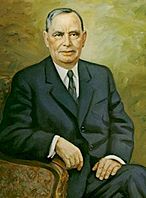United States House of Representatives elections, 1946
|
|
|||||||||||||||||||||||||||||||||||||||||||||
|---|---|---|---|---|---|---|---|---|---|---|---|---|---|---|---|---|---|---|---|---|---|---|---|---|---|---|---|---|---|---|---|---|---|---|---|---|---|---|---|---|---|---|---|---|---|
|
|||||||||||||||||||||||||||||||||||||||||||||
|
All 435 seats to the United States House of Representatives 218 seats were needed for a majority |
|||||||||||||||||||||||||||||||||||||||||||||
|
|||||||||||||||||||||||||||||||||||||||||||||
|
|||||||||||||||||||||||||||||||||||||||||||||
Elections to the United States House of Representatives for the 80th United States Congress took place in 1946. These midterm elections occurred 19 months after President Harry S. Truman assumed office upon the death of Franklin D. Roosevelt.
Truman was Vice President under President Franklin D. Roosevelt and was thrust into the presidency following Roosevelt's death. Truman did not garner the same support as the deceased president. Democrats had controlled Congress since 1931, for 16 years, and Roosevelt had been elected to a record four terms in office. In the 1946 election, the election resulted in Republicans picking up 55 seats to win majority control. Joseph William Martin, Jr., Republican of Massachusetts, became Speaker of the House, exchanging places with Sam Rayburn, Democrat of Texas, who became the new Minority Leader. The Democratic defeat was the largest since they were trounced in the 1928 pro-Republican wave that brought Herbert Hoover to power.
...
Wikipedia



